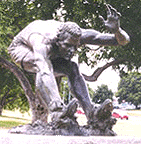|
Údarás cannot attract
outside investors to Connemara Gaeltacht Údarás na Gaeltachta is now
finding it almost impossible to attract outside investors into the more peripheral Gaeltacht areas
in Connemara. And this is likely to be a major talking point when the Údarás
convenes a special meeting in Furbo (sic) on September 10 to discuss future strategy for the
development of the Gaeltacht.
While more outlying areas were
able to attract some factory-type industries in the past, these have now headed
for countries that have cheaper production costs than Ireland. Hopes were high
that industries based on technology could locate in Gaeltacht communitities far
removed from towns, but it has not worked out like that; people in these
services also want to stay close
to the larger urban areas, according to Údarás na Gaeltachta sources. Údarás's Chief Executive, Ruan
Ó Bric put the situation in stark terms in a recent letter to a community
development group in Carna in Connemara. The Údarás, Mr. Ó Bric said, is
finding it difficult to attract any type of jobs into the Gaeltacht now, and even when that occurs, the
investors want to stay in the Furbo/Spiddal and Inverin (sic) area closer to
Galway city. No major outside investor has
located in the area west of Inverin in the past five years or more, despite
intensive efforts to bring in jobs
to high unemployment areas in the west Connemara Gaeltacht. The latest Census figures show
that communities in the Lettermore/Lettermullen and Carna (sic) areas are among the top 10 worst
unemployment blackspots in Ireland, and areas like Ros Muc (sic) and the Aran
Islands are not far behind in the jobless stakes. "It is a
crisis," says Cllr. Seosamh Ó
Cuaig, a member of the Údarás na Gaeltachta Board from Cill Chiaráin (sic) in
west Connemara. "If the State does not adopt a new approach to engendering
life into communities like the west Connemara and Aran Islands Gaeltacht, the place is doomed. "Up to now, we, in this
country, are not really focused on building-up the small rural communities. In
Norway, for example, they have a strong rural policy and that has kept vibrant
communities in the coastal regions of that country." Cllr. Ó Cuaig said that Údarás
na Gaeltachta could not now offer anything to industrialists and job-providers
that they would not get in other parts of the country. "Worse still, we are
facing a lowering of grant aid if the west of Ireland loses its Objective One
status in Europe after 2006," Cllr. Ó Cuaig claims. The difficulties being
encountered by Údarás na Gaeltachta in bringing investment to much of the
Connemara Gaeltacht is set against
a backdrop of a continuing decline in the young population in that area. Several
schools along the coastline from Casla to Cama appear set to lose teachers in
the next year or two and as many as four schools in that area may be in danger
of closure inn the coming years. As the decline in several
Gaeltacht areas continues, Údarás na Gaeltachta's Assistant Chief Executive,
Pádraig Ó hAoláin, explains that the Gaeltacht Authority is working in a
"hugely competitive environment" in trying to attract in jobs from
the outside. "The IDA are finding it
very difficult to winn projects for Ireland in the intense international
competition," Mr Ó hAoláin said. "The statistics then show that the
vast bulk of innward investment into the country is goinng to the eastern
seaboard. Our situatinon in the Údarás has to be seen in that context." Mr. Ó hAoiláin said that it
was disappointing that more high technology and services such as "call
centres" were not coming to outlying Gaeltacht communities. "Our experience has been
that these people want to be in the towns, or close to the towns. They want to
be close to the services; they
want to have sufficient suitable staff available to them and they want to be
close to research and development
facilties etc." Mr. Ó hAoiláin said that the
main advantage that the Cois Fharraige to Furbo area had over other areas in
Connemara was its proximity to Gaiway city. Padraig Ó hAoiláin said that the condition of roads had
been a long-term problem for Údarás na Gaeltachta in trying to attract industry
and investors to areas further west in Connemara. We need high-quality roads
and broadband telephone networks going into outlying Gaeltacht communities,d3
he said. He explained that getting
investors interested in locating in Gaeltacht regions is a painstaking process.
"For instance, we have a team specifically assigned to revitalising the
Údarás estate in Gaoith Dobhair in Donegal. We brought in 16 different groups
to look at the facilities and only two finally expressed a real interest in
locating there." Investors tend to form a
mental picture of an area when you finally get them to pay an introductory
visit, Mr. Ó hAoiláin says, pointing out that if there are indications that the
infrastructure is not good enough and that the people are not there, it can
create a negative impression. Cllr. Ó Cuaig says that
incentives such as tax breaks, special assistance with transportation of goods
because of the distances involved
and other incentives, need to be introduced. "There is only one
direction - unfortunately - for more peripheral regions if strong new policies
are not introduced," Mr. Ó Cuaig says. By By Mairtín Ó Catháin
Connaucht Tribune 20-8-2004 |
